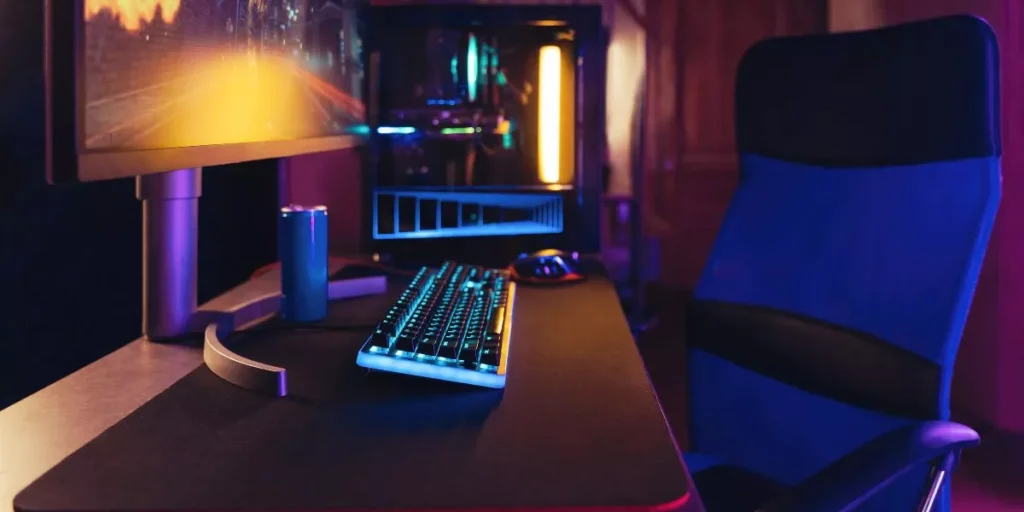
When considering the ideal size for a gaming desk, you might find yourself pondering the perfect balance between space and functionality. Picture yourself immersed in an intense gaming session, surrounded by your setup. The dimensions of your desk can significantly impact your gaming experience, affecting both comfort and performance. But what size is just right for your needs? Let’s explore how the size of your gaming desk can make a difference in creating an optimal gaming environment that caters to your unique style of play and setup requirements.
Factors to Consider
When choosing the ideal size for a gaming desk, consider functionality, ergonomics, and space constraints. Functionality is crucial for accommodating your gaming setup, including your monitor, keyboard, mouse, and any additional accessories you use. A desk that’s too small may lead to a cluttered and cramped space, affecting your gaming experience. On the other hand, a desk that’s too large could result in unnecessary reaching and discomfort during gameplay.
Ergonomics play a vital role in ensuring your comfort and health while gaming. The desk height should allow your arms to rest comfortably at a 90-degree angle while using your keyboard and mouse. Additionally, the desk depth should provide enough space for your monitor to be at eye level, reducing strain on your neck and eyes.
Lastly, consider the space constraints in your gaming area. Measure the available space to determine the maximum desk size that can fit without overcrowding the room. A well-proportioned desk won’t only enhance your gaming performance but also contribute to a more organized and visually appealing gaming setup.
Standard Desk Sizes
To understand the ideal size for a gaming desk, it’s helpful to consider the common standard desk sizes available in the market. Standard desk sizes typically range from 48 to 72 inches in width and 24 to 36 inches in depth. These dimensions provide ample space for your gaming setup while ensuring the desk fits comfortably in most rooms.
A desk that’s 48 inches wide and 24 inches deep is a compact option suitable for smaller spaces or for those who prefer a minimalist setup. On the other hand, a desk measuring 60 inches wide and 30 inches deep offers a more spacious surface for multiple monitors, peripherals, and décor. For users with extensive gaming gear or those who like to have plenty of room to spread out, a desk that’s 72 inches wide and 36 inches deep provides the ultimate gaming experience.
Consider your room size, gaming equipment, and personal preferences when selecting a standard desk size to ensure it meets your needs and enhances your gaming setup.
Customizing Desk Dimensions
Considering customizing your desk dimensions allows you to tailor the workspace to your specific gaming needs and preferences. When customizing your desk size, think about the space you have available in your gaming area. Measure the dimensions of the room to ensure your new desk will fit comfortably without overwhelming the space.
Customizing the width of your desk is crucial for accommodating your gaming setup. If you have multiple monitors, a wider desk can provide ample space for all your screens while still leaving room for other accessories like speakers or a microphone. Additionally, a wider desk allows for better organization of your gaming peripherals, reducing clutter and improving your overall gaming experience.
Adjusting the depth of your desk is also important. A deeper desk provides more room for your keyboard, mouse, and any additional items you may need during gaming sessions. Consider your arm’s reach and how much space you require to move your mouse freely without feeling cramped.
Optimal Setup for Gaming Performance
Customizing your desk dimensions can significantly impact your gaming performance by optimizing your setup for efficiency and comfort. When setting up your gaming station, ensure that your desk is at a comfortable height where your arms are parallel to the ground to prevent strain. Position your monitor directly in front of you at eye level to reduce neck strain and maintain proper posture. Keep your mouse and keyboard within easy reach to minimize unnecessary movements during gameplay.
Organize your desk space to eliminate clutter and distractions. Use cable management tools to keep wires out of the way and create a clean setup. Invest in a desk with ample surface area to accommodate your gaming peripherals, monitor, and any additional equipment you may need. A spacious desk allows for better organization and prevents overcrowding, giving you more room to move freely.
Lastly, personalize your setup to suit your gaming style. Whether you prefer a minimalist design or want to deck out your desk with RGB lighting, make sure your setup reflects your preferences and enhances your gaming experience. By customizing your desk dimensions and setup, you can optimize your gaming performance and create a comfortable environment for extended gaming sessions.
Gaming














